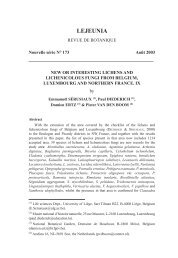The Lichens and Lichenicolous Fungi of Belgium and Luxembourg ...
The Lichens and Lichenicolous Fungi of Belgium and Luxembourg ...
The Lichens and Lichenicolous Fungi of Belgium and Luxembourg ...
Create successful ePaper yourself
Turn your PDF publications into a flip-book with our unique Google optimized e-Paper software.
Species included<br />
THE LICHENS OF BELGIUM AND LUXEMBOURG. AN ANNOTATED CHECKLIST 41<br />
Organisation <strong>of</strong> the checklist<br />
<strong>The</strong> present checklist includes all taxa <strong>of</strong> lichenized <strong>and</strong> lichenicolous fungi which have<br />
been recorded in the study area. Non-lichenized <strong>and</strong> non-lichenicolous fungi are only<br />
included if<br />
• they are loosely or doubtfully associated with algae or cyanobacteria (e. g. Naetrocymbe<br />
fraxini);<br />
• they have <strong>of</strong>ten been considered as lichens in the past (e. g. Naetrocymbe saxicola);<br />
• they have traditionally been studied by lichenologists (e. g. some species <strong>of</strong> Caliciales);<br />
• they are fungicolous on species occasionally considered as lichens (e. g. Nectriopsis<br />
indigens on Naetrocymbe saxicola);<br />
• they are genuinely non-lichenized fungi that look like lichens <strong>and</strong> have never been<br />
collected <strong>and</strong> studied by other mycologists (e. g. species <strong>of</strong> Lichenothelia <strong>and</strong> Peridiothelia).<br />
We also include some lichenicolous species which are likely to be just saprotrophic <strong>and</strong><br />
not truly (i. e. obligatory) lichenicolous. <strong>The</strong> non-lichenized genera Mniacea Boud. <strong>and</strong><br />
Sarea Fr. have not been included.<br />
As a rule, we only accept taxa (written in boldface) for which we have studied the<br />
corresponding specimens, <strong>and</strong> published relevant data in one <strong>of</strong> our recent papers. Thus,<br />
species which have never been published from the study area are never included: there is<br />
thus no new report <strong>of</strong> the occurrence <strong>of</strong> any species in the study area. For some poorly<br />
known genera, like Verrucaria, we also accept a limited number <strong>of</strong> species which have<br />
been published rather recently by other lichenologists, but for which we have not examined<br />
any material. Older published records for which we were unable to examine any<br />
corresponding specimens have not been accepted, unless otherwise stated; such species<br />
which are doubtfully present in the study area are listed after the accepted taxa, <strong>and</strong> are<br />
printed in italics.<br />
Data provided for each species<br />
For each accepted taxon, listed in alphabetic order, the following data are provided (some<br />
being optional):<br />
• the name, possibly preceded by the symbol (*) if it is a lichenicolous lichen, * if it is a<br />
lichenicolous fungus, (+) if it is a doubtfully lichenized fungus, <strong>and</strong> + if it is a nonlichenized<br />
fungus;<br />
• common synonyms, <strong>and</strong> synonyms found in the literature <strong>of</strong> the study area [for <strong>Belgium</strong>,<br />
the literature published after Duvigneaud & Giltay (1938), <strong>and</strong> for <strong>Luxembourg</strong>,<br />
that published after Koltz (1897) has been screened for synonyms];<br />
• known or presumed teleomorph or anamorph connections;





